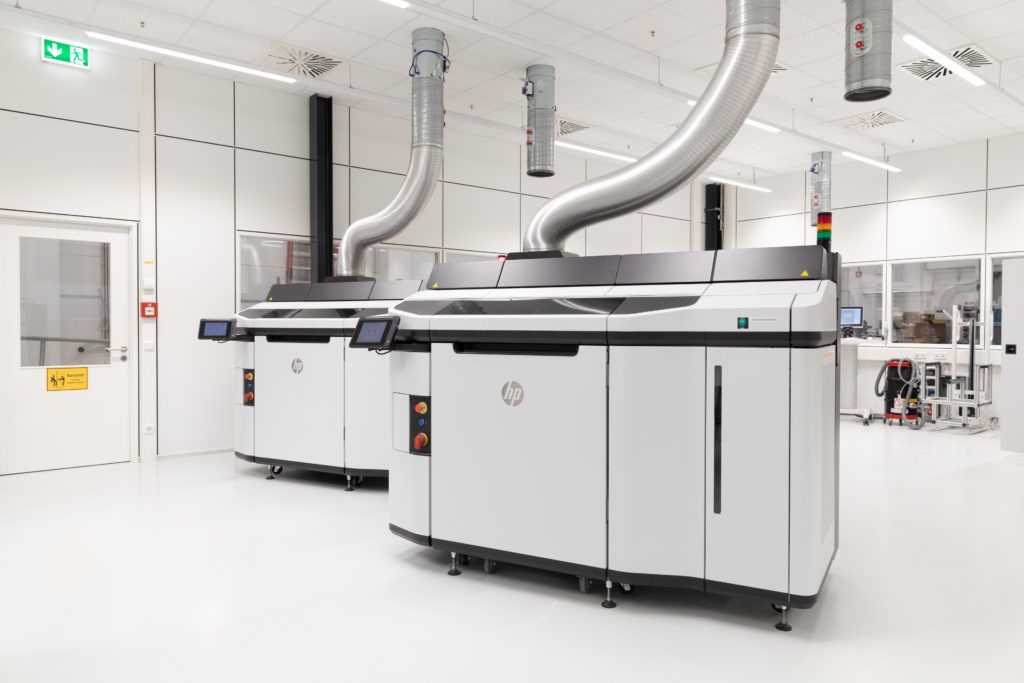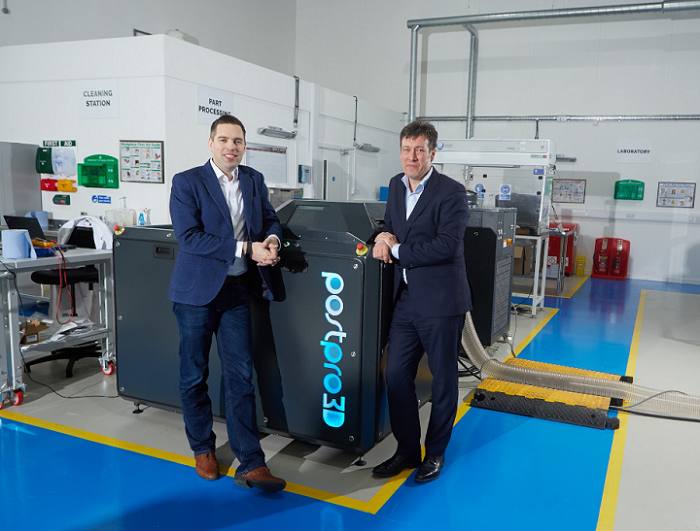It used to be considered 3D printing’s “dirty secret.” Now, however, post-processing isn’t just a well-known aspect of the industry, but it is a thriving subsegment in itself. Just read SmarTech’s report, “Automation, Additive Manufacturing and the Factory of the Future,” to get an understanding of how the technology is key to the “lights-out” nature of robotic 3D printing plants.
At the present, there are only really a handful of firms in the sector and, among them, AMT is a standout. This is in part due to the high-profile customers that have adopted AMT’s solutions, as well as the fact that it seems to be the only post-processing company focused on tackling the whole segment and not just finishing solutions for this or that additive manufacturing (AM) technology. To learn more about this crucial segment and AMT’s role within it, we spoke to CEO Joseph Crabtree.
Automating the 3D Printing Workflow
AMT’s bread and butter is currently vapor smoothing and depowdering equipment for polymer 3D printing technologies. Its chemical vapor process can be seal otherwise porous parts made with material extrusion or powder bed fusion techniques, giving them a vibrant, injection molding-style finish. Depowdering is specifically for powder bed fusion and uses shot blasting to ensure that parts are free of material particles before further processing.
In addition to actual finishing of 3D printed parts, there are other aspects of the 3D printing workflow that are in the process of being automated. In fact, almost a decade ago, AM firms like Concept Laser and Additive Industries were promising robotic systems capable of conveying powder and finished parts around the factory floor. Years later, companies like AMT are actually working to deliver such solutions.
Collaborating with the University of Nottingham and through its own internal research, the firm is working to enable robots to identify, pick-and-place, and transport parts. While the image of machines automatically moving components throughout a facility may be what sparks the imagination most, it’s the software that is the more complex task.
“Replacing a human operator is actually quite complex because humans are very good at performing tasks like, for example, hooking parts onto a rack and then loading the rack into a machine. Whereas robots can do that task in a repeatedly, reproducible manner with 200,000 identical injection molded parts, it’s very hard to actually get a robot to understand where the center of gravity of a 3D printed part is—how to pick and place that part, and then how you quality inspect and all of those kind of attributes that a human is very, very good at, but robotics systems are not so good. If every part is different, then that’s a level of complexity that’s quite a challenge to automate in the workflow.”
To accomplish this task, the company is working with Oechsler, a German injection molding company with over 150 years in the business. Together with HP, the partners will work to fully automate the production to finishing workflow. Slated to be completed over the course of a year-and-a-half, the project will see a cell for automatically post-processing parts from 10 HP Multi Jet Fusion printers at once.
“Our work with Oechsler is going to involve all these different steps, which is the physical side of post-processing for finishing, but then also how you overlay the digital side, which is obviously the software. In essence, how you replace the human operator and make it a truly touchless system. And that’s the problem because the beauty of 3D printing is that every part can be different.”
The challenge is integrating software, hardware, machine learning, vision systems, and 3D printer into a single cell. This means digital connecting and interfacing with HP machines, removing part automatically, and processing them. Because MJF printers weren’t designed for this sort of workflow initially, it means modifying the equipment.
“We’re pushing the design envelope of all of the hardware and ensuring that it’s fit for purpose in terms of a manufacturing sense,” Crabtree said.
Crabtree believes that the first production line will be delivered in early 2023. When it is, it will be used for high-end, visible parts for automotive, medical, furniture-making, and other applications. Really, it signals a new era in AM.
“I think that the key part about this is that the end customer is known in the public markets. These are automotive parts for Class A surface finishes,” Crabtree said. “These are parts can be ordered on the automotive OEM’s website, where they can be specified for your car, and are parts that are of the most critical quality Class A surface finish. We’re not just talking about a widget that sits under the dashboard. It’s something that is very visible, high end automotive cars in this space.”
A Solutions Provider
Out of all the few companies involved in post-processing, AMT has the unique strategy of working toward complete solutions. That is, it is developing solutions for a variety of polymer additive processes, with metal in the works.
The reason behind this is simple enough: new 3D printing users don’t necessarily understand the industry. That is, new customers may see the additive space as being very complicated, unsure of what technologies or materials are best suited for a given application.
“The biggest challenge is from the customer’s perspective is actually the choice. The user journey is still not simple. If you buy an injection molding machine, it’s really obvious what to do. You have some tooling made. You know what materials go in there. It’s a known process. With 3D printing, we’re not quite sure how we scale production. That’s the gap that we’re trying to bridge.”
Rather than leave a manufacturer to figure out what to do for themselves, AMT provides a tailored solution. “It’s not just, here’s a machine that smooths parts, or here’s a machine that cleans parts. It’s a solution that’s tailored to your exact needs. And those needs may be different depending on if you’re producing a running shoe, a widget for medical applications, or an automotive part. And I think that’s the trick the industry as a whole is missing,” Crabtree said.
He continued, “And that’s one of the reasons that Oechsler contracted us. Not only do we provide the physical building blocks for an end-to-end solution and can have the overarching software, machine learning, and vision recognition systems. We’re offering a customizable and tailored solution that’s the right fit for them. And I think that, as we go through the next months and years, you’ll start to see that consolidation of materials and printer companies with these finishing companies and software companies and providing these one-stop solutions.”
Market Consolidation
Given the merger and acquisition activity that briefly flourished in 2021, as well as the increasing size of the companies entering the AM industry, we should expect further consolidation in the future. That is, if the overall market conditions improve, perhaps in the next 18-24 months.
When that activity does pick up, Crabtree agreed that we will see more consolidation. In order to offer post-processing equipment or one-stop AM solutions, some machine manufacturers like HP, 3D Systems, or Stratasys, may consider the acquisition route. However, the post-processing space is still underdeveloped, so a potential purchaser will probably want to wait for the existing businesses to grow the space sufficiently before swooping in.
At the moment, Stratasys has chosen DyeMansion for its selective absorption fusion technology, while 3D Systems and HP work more closely with AMT and Carbon collaborates with PostProcess Technologies. Could we see mergers take place between these firms? Another option could be for a large conglomerate to jump into the industry and acquire both printer manufacturers and post-processing companies to form a complete AM division.
“The value is in companies like AMT basically doing the painful work, developing all the hardware and the ecosystem. Then, I can see a time where a printer OEM would consolidate,” Crabtree said. “Now, of course, then it’s a question of scaleof the OEM. Does someone come along and buy a printer company and a post processing company? The acquiring firm would need to be big enough and the market size needs to be big enough to justify that.”
The Next Stage
The growth that will happen on AMT’s part will not only be greater automation, but also a broader product portfolio. This includes smoothing of metal parts. The startup has performed fundamental research in the space and has been granted a number of patents for post-processing of metal 3D printed parts. In fact, it has already begun selling systems for cleaning metal parts. An official metal post-processing line, however, won’t make it to market for another 18 to 24 months.
Once this happens, this will make AMT the only business that manufactures both metal and polymer post-processing solutions. Surely, other firms in the space are racing to catch up. However, AMT is already much farther along and whether or not the competition can actually do so without consolidation remains to be seen.
Subscribe to Our Email Newsletter
Stay up-to-date on all the latest news from the 3D printing industry and receive information and offers from third party vendors.
You May Also Like
3D Printing Webinar and Event Roundup: April 28, 2024
In this week’s 3D Printing Webinar and Event Roundup, the Ceramics Expo is taking place in Michigan, Stratasys continues its advanced training courses, and SPE is holding a Polymer Characterization...
Initial Speakers and Sponsors Announced for Additive Manufacturing Strategies 2025
Nearly a year away from the event, the Additive Manufacturing Strategies (AMS) 2025 conference is already beginning to take shape. Building upon the success of 2024’s summit, AMS has established...
HP & INDO-MIM Collaborate to Boost Metal 3D Printing in India
HP Inc. and INDO-MIM, a US- and India-based supplier of metal injection molding (MIM) powders and contract manufacturer, have announced that the two companies will collaborate to accelerate additive manufacturing...
One of US’s Largest Machine Tool Resellers to Offer Stratasys 3D Printing
In a key move for the additive manufacturing (AM) stalwart, Stratasys (Nasdaq: SSYS) has announced a strategic partnership with Select Additive Technologies, a division of Morris Group, Inc., which is...


































